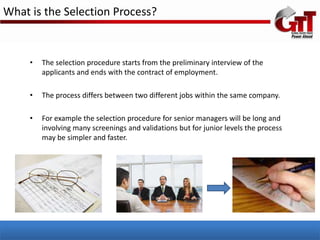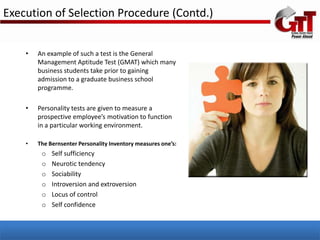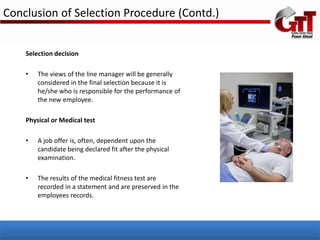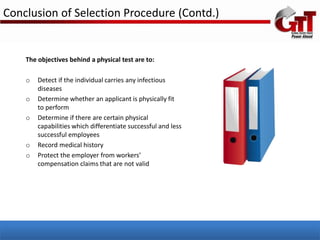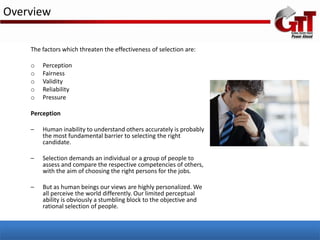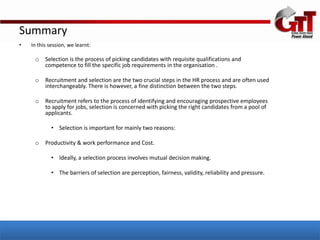Session 6(a) measurement & decision making issues in selection
- 2. Objectives • After completing this session on employee selection process, you will be able to: – Explain meaning & Importance of employee selection – Discuss the role of HR in employee selection – Explain the process of employee selection – Discuss some barriers to effective selection
- 3. Topics • Following are the topics included in this session: – Meaning and Importance of Employee Selection – Role of HR in Employee Selection – Process of Employee Selection – Barriers to Effective Selection – Summary
- 4. Meaning and Importance of Employee Selection In this topic, we will discuss about meaning and importance of employee selection.
- 5. What is Selection? • Selection is the process of picking candidates with requisite qualifications and competence to fill the specific job requirements in the organisation. • The basic purpose of selection process is choosing the right type of candidate. • In order to achieve this basic purpose, a well-organized selection procedure is needed that involves many steps. • The objective at each step is to gather more and more information about the candidate and thereby help in selection of the right candidate. • Although, some selection includes getting candidates from within the company by promotion or transfer, we shall look at selection from outside the organisation . • This is called selection from external sources.
- 6. Difference Between Recruitment and Selection • You might begin to wonder that all this sounds like recruitment activities. • Recruitment and selection are the two crucial steps in the HR process. • Both the functions are integrated with the common objective of identifying the right person for the right job. • Recruitment refers to the process of identifying and encouraging prospective employees to apply for jobs. • Selection is concerned with picking the right candidates from a pool of applicants.
- 7. Difference Between Recruitment and Selection (Contd.) • Difference between recruitment and selection No. Recruitment Selection 1 Recruitment is the process of searching for The process of selection leads to employment of persons having prospective employees and stimulating them to the ability and qualifications to perform the jobs, which have apply for jobs in the organisation . fallen vacant in an organisation . 2 Recruitment is said to be positive in its approach as Selection is negative in its application in as much as it seeks to it seeks to attract as many candidates as possible. eliminate as many unqualified applicants. It divides the candidates for employment into those who will be offered, and those who will be rejected. 3 The purpose of recruitment is to create a large pool Selection aims at eliminating unsuitable candidates and ensuring of applicants for the jobs in the organisation . most competent people for the jobs. 4 Recruitment is a simple process as the candidates Selection is a complex and lengthy process under which the are required to fill in the prescribed forms and candidates have to pass through a number of stages before deposit with the employer. getting the job offer.
- 8. Importance of Employee Selection Employee selection is a very important mainly for two reasons. o Productivity and work performance o Cost • Work performance depends on individuals. • The best way to improve performance is to hire people who have the competence and the willingness to work. • This becomes more apparent as poor or inappropriate choice can be demoralizing to the individual concerned and de- motivating to the rest of the workforce.
- 9. Role of HR in Employee Selection In this topic, we will discuss about the role of HR in employee selection.
- 10. Whose Role is it Anyway? • Recruitment and selection are always planned activities. • The control rests in some hands even if the responsibilities are not clearly defined. • In some companies, each department screens and hires its own employees. • Many managers insist upon selecting their own people. • All these factors must be considered as human dynamics are equally important for candidates fitting into the company. • However, selection is mostly centralized and is handled by the human resource department.
- 11. Advantage - HR • The arrangement of HR handling the recruitment process is preferable because of the following advantages. • It is easier for the applicant because they can send their applications to a single centralized department/agency. • It facilitates contact with applicants because issues pertaining to employment can be cleared through one central location.
- 12. Advantage – HR (Contd.) • It helps operating managers to concentrate on their operating responsibilities. This is especially helpful during peak hiring periods. • It can provide for better selection because hiring is done by specialists trained in staffing techniques. • The applicant is better assured of consideration for a greater variety of jobs. • Hiring costs may be cut because duplication of effort is minimized. • With increased government regulations on the selection process, it is important that people who know about these rules to handle a major part of selection process.
- 13. Candidate – Company Fitment • Ideally, a selection process involves mutual decision making. S • How much to pay? What facilities to offer? C R E • Will the offer meet my needs? E N I • When the job market is extremely tight, several N G candidates will be applying for a position. • The firm will use a series of screening techniques to hire the candidate they are looking for. • When there is a shortage of qualified workers, or when the candidate is a highly qualified executive, the company will have to soften their approach and make appropriate and lucrative offers and come to a quick decision.
- 14. Process of Employee Selection In this topic we will discuss the process of employee selection.
- 15. What is the Selection Process? • The selection procedure starts from the preliminary interview of the applicants and ends with the contract of employment. • The process differs between two different jobs within the same company. • For example the selection procedure for senior managers will be long and involving many screenings and validations but for junior levels the process may be simpler and faster.
- 16. Implementation of Selection Strategy The steps of the employee selection are: 1. Determine the environmental factors affecting selection 2. Determine the internal factors affecting selection 3. Conduct basic and preliminary interview 4. Conduct selection tests 5. Conduct employment interview 6. Make the selection decision 7. Conduct physical or medical test 8. Award job Offer 9. Award contract of employment
- 17. Implementation of Selection Strategy (Contd.) Determine the environmental factors affecting selection Environmental • Selection is influenced by several factors. Factors • Prominent factors are: o Supply and demand of specific skills o Unemployment rate o Economic conditions o Legal and political conditions o Company’s image in the industry Determine the internal factors affecting selection • Internal factors influencing selection are: Internal Factors o Company’s policy o HRP o Cost of hiring
- 18. Execution of Selection Procedure • Basic and preliminary interview • All the applications received from job seekers would be subject to scrutiny so as to eliminate unqualified applicants. • This is usually followed by a preliminary interview the purpose of which is more or less the same as scrutiny of applications, that is, elimination of unqualified applications.
- 19. Execution of Selection Procedure (Contd.) • Screening enables the HR specialists or the recruiters to eliminate unqualified job seekers based on the information supplied in their application forms. • Preliminary interview, on the other hand, helps reject misfits for reasons, which did not appear in the application forms. • The objective of the first round of interview is to: o Validate whether the information given on the resume is correct or not o Find out the relevant information needed, but not given in the resume or application
- 20. Execution of Selection Procedure (Contd.) Selection tests • Different types of test may be administered, depending on the job and the company. • Tests are used to determine the applicant’s: o Ability o Aptitude o Personality • Ability tests assist in determining how well an individual can perform tasks related to the job. • An excellent illustration of this is the typing test given to a prospective employee for a data entry job. • An aptitude test can help determine a person’s potential to learn in a given area.
- 21. Execution of Selection Procedure (Contd.) • An example of such a test is the General Management Aptitude Test (GMAT) which many business students take prior to gaining admission to a graduate business school programme. • Personality tests are given to measure a prospective employee’s motivation to function in a particular working environment. • The Bernsenter Personality Inventory measures one’s: o Self sufficiency o Neurotic tendency o Sociability o Introversion and extroversion o Locus of control o Self confidence
- 22. Execution of Selection Procedure (Contd.) • The Thematic Apperception Test (TAT) assesses an individual’s achievement and motivational levels. • Interest tests are used to measure an individual’s activity preferences. • Graphology tests are used to analyse an individual’s personality traits based on his/her handwriting.
- 23. Execution of Selection Procedure (Contd.) Employment Interview • Interview is a formal, in-depth conversation conducted to evaluate the applicant’s acceptability. • Shortcoming of interviews • Absence of reliability is one limitation. • No two interviewers offer similar scoring after interviewing an applicant. • Biases of interviewers may cloud the objectivity of interviews.
- 24. Conclusion of Selection Procedure (Contd.) Selection decision • The views of the line manager will be generally considered in the final selection because it is he/she who is responsible for the performance of the new employee. Physical or Medical test • A job offer is, often, dependent upon the candidate being declared fit after the physical examination. • The results of the medical fitness test are recorded in a statement and are preserved in the employees records.
- 25. Conclusion of Selection Procedure (Contd.) The objectives behind a physical test are to: o Detect if the individual carries any infectious diseases o Determine whether an applicant is physically fit to perform o Determine if there are certain physical capabilities which differentiate successful and less successful employees o Record medical history o Protect the employer from workers’ compensation claims that are not valid
- 26. Conclusion of Selection Procedure (Contd.) Job Offer • Job offer is made through a letter of appointment. • Such a letter generally contains a date by which the appointee must report on duty. • The appointee must be given reasonable time for reporting and movement of property. • As a good practice, the rejected applicants should be informed about their non-selection. • Such candidates must be told that they were not selected because their profiles did not match the requirements of the company.
- 27. Conclusion of Selection Procedure (Contd.) Contract of Employment • Previous employment records and all necessary educational documents need to be attested and submitted to the company for future reference. • Once that is scrutinized, a contract of employment is drawn. • A contract of employment is a written contract that lays down the terms and conditions of employment between the company and the selected candidate.
- 28. Conclusion of Selection Procedure (Contd.) The components of a contract of employment are: 1. Job title 2. Duties and responsibilities 3. Date when continuous employment starts 4. Probation period, if any 5. Salary, allowances and any other payment 6. Hours of work including lunch break and shift arrangements 7. Leaves permitted 8. Notice period 9. Grievance procedure 10. Disciplinary procedure 11. Work rules 12. Termination clause 13. Employer’s right to vary terms of the contract subject to proper notification being given 14. Employment bonds or non-disclosure agreement, if applicable
- 29. Barriers to Effective Selection In this topic we will discuss the barriers to effective selection.
- 30. Overview The factors which threaten the effectiveness of selection are: o Perception o Fairness o Validity o Reliability o Pressure Perception – Human inability to understand others accurately is probably the most fundamental barrier to selecting the right candidate. – Selection demands an individual or a group of people to assess and compare the respective competencies of others, with the aim of choosing the right persons for the jobs. – But as human beings our views are highly personalized. We all perceive the world differently. Our limited perceptual ability is obviously a stumbling block to the objective and rational selection of people.
- 31. Overview (Contd.) Fairness – Fairness in selection requires that no individual should be discriminated against on the basis of religion, region, race, or gender. – But the low numbers of women and other less-privileged sections of the society in middle and senior management positions show that all the efforts to minimize inequity have not been very effective. Validity – Validity is a test that helps predict the job performance of an incumbent. – A test that has been validated can differentiate between the employees who can perform well and those who will not. – However, a validated test does not predict job success accurately. It can only increase possibility of success.
- 32. Company Level Responsibility Reliability – A reliable method is one which will produce consistent results when repeated in similar situations. – Like a validated test, a reliable test may fail to predict job performance with precision. Pressure – Pressure is brought on the selectors by politicians, bureaucrats, relatives, friends and peers to select particular candidates. – Candidates selected because of compulsions are obviously not the right ones.
- 33. Summary This topic summarise the entire module.
- 34. Summary • In this session, we learnt: o Selection is the process of picking candidates with requisite qualifications and competence to fill the specific job requirements in the organisation . o Recruitment and selection are the two crucial steps in the HR process and are often used interchangeably. There is however, a fine distinction between the two steps. o Recruitment refers to the process of identifying and encouraging prospective employees to apply for jobs, selection is concerned with picking the right candidates from a pool of applicants. • Selection is important for mainly two reasons: o Productivity & work performance and Cost. • Ideally, a selection process involves mutual decision making. • The barriers of selection are perception, fairness, validity, reliability and pressure.
- 35. Congratulations! You have successfully completed the session ‘Employee Selection Process.’














